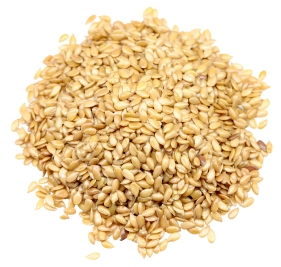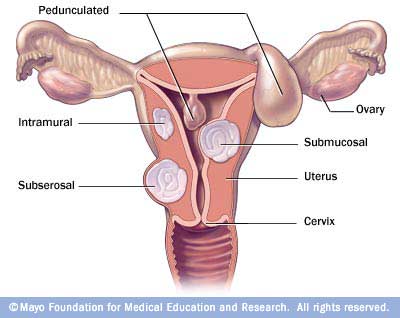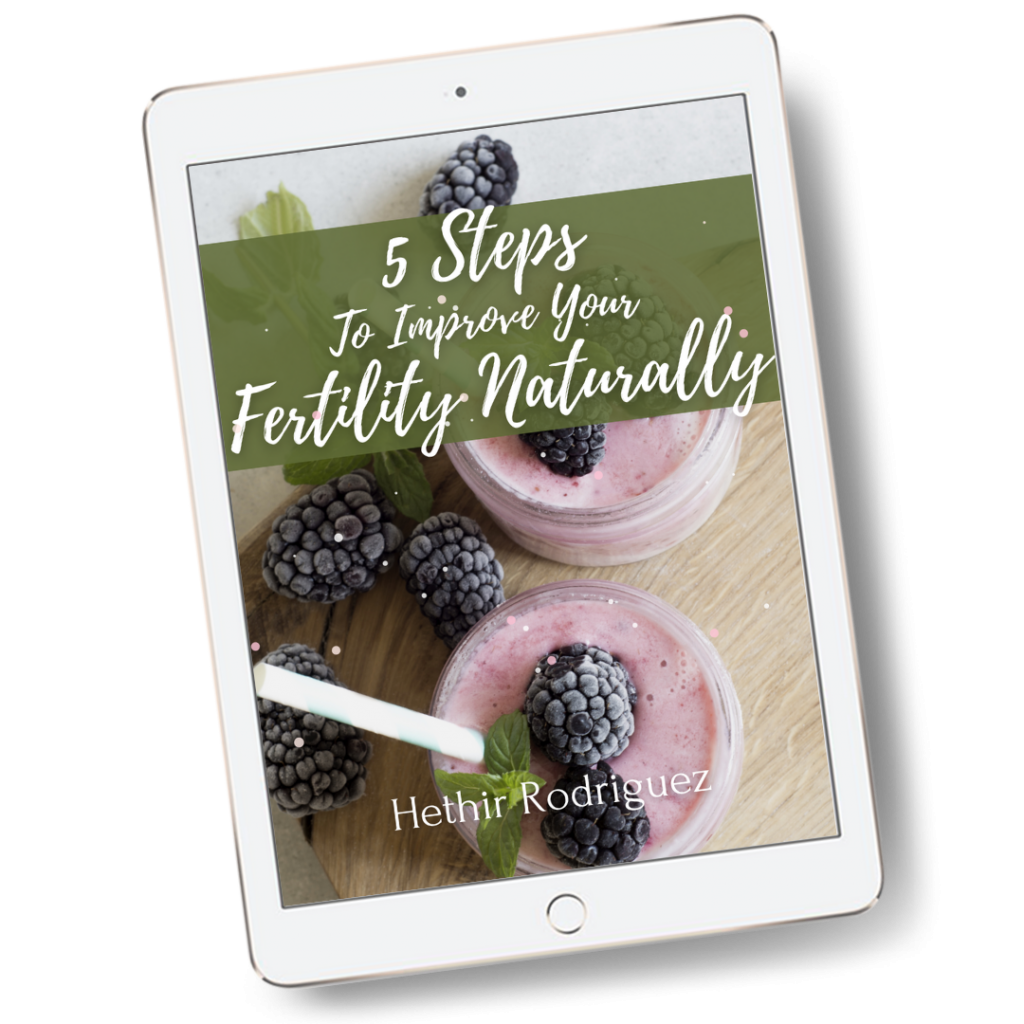Uterine fibroids are non-cancerous tumors of the uterus. Uterine fibroids are also known as leiomyomata, myomas or uterine polyps. Uterine fibroids grow within the muscles of the uterus, on the outside of the uterus, hang in the uterine cavity (referred to as a uterine polyp) or very rarely form within the cervix. They can range in size from microscopic to several inches in diameter. Uterine fibroids form in the childbearing years of a woman’s life. There may be just one fibroid or many, with differing locations. Uterine fibroids are rarely a cause for concern, but when they become too large, or there are many present, they may become a problem. In this article, we will discuss the different types of fibroids, causes, symptoms, medical treatments, and a natural therapy plan including Fertility Cleansing, eating a fertility diet, herbs, and Self Fertility Massage.
Types of Uterine Fibroids
Submucosal: grow in the innermost layer of the uterus
Intramural: grow in the middle layer of the uterus
Subserosal: grow in the outer wall of the uterus
Pedunculated: attached to a stalk either outside of the uterus or within the uterine cavity
Cervical: in the cervical tissue
Interligamentous: between the uterine broad ligaments
Causes of Uterine Fibroids
Though 20% – 80% of women by age 50 will develop uterine fibroids, according to the Office on Women’s Health at the U.S. Department of Health & Human Services, doctors are actually unsure of what causes them to occur. What they do know, however, is that estrogen and progesterone contribute to the growth of the fibroids.
Researchers at the National Institutes of Health (NIH) understand that “reproductive hormones like estrogen appear to stimulate cells to release growth factors (growth factors are chemicals secreted by cells which stimulate other cells to increase in size and number and to differentiate into specialized types of cells…)”
Estrogen and progesterone are at their highest levels during a woman’s childbearing years; this is why uterine fibroids are thought to develop during this time. Normally, after a woman goes through menopause, her body produces lower levels of estrogen and progesterone causing the fibroids to begin to shrink and any associated symptoms, such as pain and pressure to subside.
Uterine fibroids are hormone dependent. They develop during the hormonally active years and decline in menopause. Fibroid tissue has a higher amount of estrogen and progesterone receptors. Fibroid tissue is hypersensitive to estrogen, but does not have the capacity to regulate the estrogen response; this is why they can grow to become quite large. Other hormones play a role in the growth of uterine fibroids as well, including prolactin, parathyroid hormone, insulin growth factor, and pituitary growth hormone.
Fibroids are two to three times more likely to develop in African American women compared to any other ethnicity. In one case study highlighted in the New England Journal of Medicine, Elizabeth A. Stewart, M.D., of the Division of Reproductive Endocrinology and Infertility at the Mayo Clinic shares, “The lifetime prevalence of fibroids exceeds 80% among black women…”
Factors that May Increase Fibroid Development
An increase in lifetime exposure to estrogen:
There are many factors that increase a woman’s lifetime exposure to estrogen. More than at any other time in history, women are exposed to more estrogen. This increased exposure can contribute to a wide variety of reproductive health problems, including the development of uterine fibroids. The following factors increase a woman’s lifetime exposure to estrogen:
- Early menarche – the longer a woman has her menstrual cycle, the longer estrogen levels are elevated
- Fewer pregnancies – many women today are restricting how many children they are having or are not having children at all, which increases their total exposure to estrogen
- High body fat content – body fat produces and stores estrogen; the more body fat a woman has the more estrogen she has
- Exposure to xenoestrogens – plastics, pesticides, herbicides, synthetic hormones in both meat and dairy products, and hormone replacement therapy (HRT) including oral contraceptives (birth control) containing synthetic estrogen
- Poor estrogen metabolism – some women’s bodies have a harder time removing and metabolizing excess estrogen
In addition to exposure to estrogen, the following factors may also play a role in the development of uterine fibroids:
- Hypertension
- Infection complications from IUD use
- Perineal talc use
- Anovulatory cycles
- Endometrial hyperplasia (common in women with PCOS)
Symptoms of Uterine Fibroids
While many women will never even know that they have uterine fibroids, because the condition often exhibits no symptoms, there are some women that will experience certain effects from the fibroid’s presence. Symptoms of uterine fibroids include:
- A sensation of fullness or pressure in the abdominal area
- Excessive bleeding during menstruation
- Excessive length of menstruation
- Extreme cramping during menstruation
- Lower back pain
- Painful intercourse
- A frequent urge to urinate
Uterine Fibroids May Negatively Impact Conception and Pregnancy
Fibroids are thought to be the cause of infertility in 2%-10% of infertility cases. Reports have shown uterine fibroids may be responsible for the following fertility, conception, and pregnancy problems:
- Interference with implantation of the ovum
- Compressing the fallopian tubes, preventing conception
- Anovulatory cycles
- Abnormal uterine blood flow, hindering movement of sperm to ova
- Miscarriage
- Intrauterine growth retardation (IUGR)
- Premature rupture of the membranes
- Contributing to retained placenta after birth
- A postpartum hemorrhage
- An abnormal labor
Not all women with uterine fibroids will experience these kinds of troubles and many go on to have healthy pregnancies even with uterine fibroids present. Because there are risks to your fertility and possibly pregnancy, it is best to work to reduce fibroid growth, prevent formation of new fibroids, and to maintain healthy lifestyle choices to continue working to bring about the best possible uterine health.
Medical Treatment for Uterine Fibroids
In many cases, the effects of uterine fibroids are so minor that often these women use a general over-the-counter pain medicine to treat any cramping or pain associated with the fibroid tumors. Since the tumors can also cause excessive menstrual bleeding, which can lead to anemia, an iron supplement is recommended if excessive bleeding is occurring.
In the medical world, the only “successful” treatment for uterine fibroids is removal. I say successful lightly, especially in the case of removal of the uterine fibroids alone, as new ones can develop post-surgery and any remaining parts of older fibroids can begin to grow back. There are four ways in which doctors aim to remove uterine fibroids:
Uterine fibroids can be quite hard to treat naturally or through hormonal medications prescribed by doctors. If, after trying either hormonal medications or natural therapies you continue to suffer from uterine fibroids, it may be time to seriously consider surgical options. Neither doctors nor natural healthcare practitioners have been able to find an exact solution for getting rid of uterine fibroids permanently. Even after surgery, uterine fibroids may grow again or new ones may form. This is why step 1 under our Natural Therapies guide below is extremely important. It is vital to reduce exposure to xenohormones and continue to eat well to keep estrogen levels in balance.
Natural Therapy Plan for Uterine Fibroids
Step 1: Cleanse, reduce exposure to xenoestrogens, promote healthy estrogen metabolism
Fertility Cleansing
The best way to begin any natural fertility plan would be to do a Fertility Cleanse. A fertility cleanse encourages the liver to cleanse the body of toxins and excess hormones. It also supports the uterus to cleanse itself of old stagnant blood and increases circulation to the uterus while tonifying the uterine tissues.
Reduce Exposure to Xenohormones
Exposure to certain environmental toxins may contribute to the development of uterine fibroids. NIH researchers are investigating the impact of pesticide or other chemical(s) exposure has on hormones might interact with the growth factors known to stimulate uterine fibroid growth mentioned earlier in this guide.
Xenoestrogens are a subclass of endocrine disruptors. Endocrine disruptors, also known as xenohormones, are human-made chemicals. These chemicals have the ability to interfere with the natural functions and development of our bodies. The main function of the endocrine system is to serve as our body’s message center. Hormones deliver messages; the endocrine system coordinates hormones.
Xenoestrogens have the ability to bind to our estrogen receptor sites. This is particularly concerning for women with uterine fibroids. This is because fibroid tissue is hypersensitive to estrogen; it contains a high number of estrogen receptors; this is why they can grow to become quite large. Exposure to xenoestrogens can fuel uterine fibroid growth.
Ways to Avoid Xenohormones:
- Eat organic foods
- Avoid exposure to pesticides, herbicides, and synthetic fertilizers
- Use natural feminine care products
- Use organic, natural body care products, including makeup
- Avoid food preservatives and dyes
- Use low VOC paints
- Use recycled unbleached paper products
- Use non-chlorinated oxygen-based bleach in the laundry
- Avoid plastics
Known Xenoestrogens to Avoid:
- Atrazine (weed killer)
- Butylated hydroxyanisole known as BHA (food preservative)
- 4-Methylbenzylidene camphor known as 4-MBC (sunscreen lotions)
- Erythrosine, FD&C Red No. 3, (food dye)
- Bisphenol A (found in polycarbonate plastic and epoxy resin)
- Ethinyl estradiol (common in oral contraceptive pills, this is released into the environment as a xenoestrogen through the urine and feces of women who use this)
- Heptachlor and dieldrin, DDT (insecticides)
Dietary Tips for Reducing Uterine Fibroids
Without eating a whole food diet, the body will not respond to herbs, supplements or natural therapies as well. We suggest eating a nutrient-dense whole food fertility diet. This way of eating will create a foundation for a healthy, properly functioning body.
The Importance of Fiber
Your main focus and one of the first things you should do right now is eat more fiber. Fiber helps the body to get rid of excess estrogens.

Good sources of fiber:
- Dark leafy greens
- Broccoli
- Swiss chard
- Quinoa
- Chia seeds
- Beans
- Ground flaxseed
Whole Grains
Choose whole grains whenever possible and avoid white refined grains. Good choices of whole grains would be brown rice, millet, spelt, buckwheat, rye and oats.
Avoid Anti-nutrients
Avoid saturated fats, sugar, caffeine, alcohol, and junk foods, all of which may contribute to estrogen dominance. We consider these anti-nutrients, which impact fertility negatively.
Eat a diet rich in legumes, fresh vegetables, and fruits.
DIM: Support Healthy Estrogen Metabolism
Supplementation with DIM can increase the body’s natural ability to metabolize and remove excess estrogen. The goal is to help the body manage estrogen in a better way in hopes that any existing uterine fibroids will see a reduction in exposure to estrogen. In theory, this may help slow the growth of fibroids and prevent the formation of new ones.
In summary, from the work of Epidemiologist Courtney Sperlazza, MPH, DIM in part converts bad estrogens into good estrogen metabolites, some of which the body uses and others it excretes. Bad estrogen metabolites are those with the potential to exacerbate problems commonly attributed to estrogen excess; PMS, water retention, acne, low libido, uterine fibroids and endometriosis, etc.
Step 2: Increase circulation, reduce pain, manage heavy menstrual bleeding
Fibro Defense
Fibro Defense goes to the source of the problem, helping to reduce excess estrogen that fuels abnormal growths and stimulates liver activity for improved estrogen metabolism. The herbs in this blend work with your body’s natural detoxification processes to clear congested foreign tissues, while simultaneously helping to prevent new growths from forming. Fibro Defense is an excellent way to promote the health and function of uterine tissues.
To learn about other herbs that may be helpful for uterine fibroids click here…
Self Fertility Massage™
Self Fertility Massage™ is a series of massage techniques that are used to help support reproductive health, the menstrual cycle, and your fertility- all from the comfort of your own home! This type of massage is easy to learn, perform and is cost-effective!
One of the greatest benefits of massage is the ability to break up adhesions and bring in circulation to the area being massaged. Uterine fibroids may compress and compromise circulation to the uterus, fallopian tubes, ovaries or other surrounding organs. Self Fertility Massage™ helps to promote healthy circulation, helps the body to rid itself of old stagnant blood and tissues in the uterus, and promotes hormonal balance by strengthening the hormonal feedback loop. Do not do during menstruation.
Castor Oil Pack
Castor Oil Packs are an ancient therapy that helps to cleanse and heal the body where they are placed. The castor oil has a drawing power that clears the body of excess tissues and toxins. Castor oil packs stimulate the lymphatic and circulatory systems. The lymphatic system removes toxins and waste from the area stimulated by the castor oil pack. The promotion of circulation by the castor oil pack will also bring in fresh oxygenated, nutrient-rich blood to the reproductive organs, including the uterus. This is vital to reducing and dissolving uterine fibroids. Do not use during menstruation.
To purchase a kit with these ingredients and body therapies click here…
Step 3: Additional Considerations
Systemic Enzyme Therapy
We discussed earlier the benefits of the enzyme protease in Women’s Best Friend. Protease is in a class of pancreatic enzymes. Pancreatic enzymes are a part of a larger group of enzymes called systemic enzymes. Systemic enzymes may be helpful in reducing the size of uterine fibroids, healing and preventing scar tissue damage from existing uterine fibroids, promoting healthy circulation and detoxification of tissues, while reducing pain and inflammation. Learn more about the benefits of Systemic Enzyme Therapy here…
Summary
Uterine fibroids are hormone-dependent. Fibroid tissue is hypersensitive to estrogen, but does not have the capacity to regulate the estrogen response; this is why they can grow to become quite large. Because they are responsive and may develop due to exposure to estrogen, both from our own estrogen and from human-made chemicals, it is vital to reduce excess estrogen and support healthy progesterone levels to balance out unopposed estrogen. It is also vital to promote healthy circulation and detoxify the tissues in the uterus, work to manage pain if present and reduce heavy or mid-cycle menstrual bleeding due to fibroids. The overall goal is to support a healthy normal functioning uterus for a lifetime!
- Auborn, Karen J., Saijun, Fan, Rosen, Eliot M., Goodwin Leslie, Chandrasekaran, Alamelu, Williams,David E., Dazhi, Chen, Carter, Timothy H. (2003). Indole3carbinol is a negative regulator of estrogen. The Journal of Nutrition; vol. 133, no 7, SUP (109 p.) (27 ref.), pp. 2470S2475S Retrieved from: https://academic.oup.com/jn/article/133/7/2470S/4688465
- Zeligs, Michael A. (1998). Diet and Estrogen Status: The Cruciferous Connection. Journal of Medicinal Food; 1(2): 6782 Retrieved from: https://www.liebertpub.com/doi/pdf/10.1089/jmf.1998.1.67
- McDougal, Andrew. (3/ 2001). Methyl substituted diindolylmethanes as inhibitors of estrogeninducedgrowth of T47D cells and mammary tumors in rats. Breast Cancer Research and Treatment; Volume 66,Number 2. Retrieved from: https://link.springer.com/article/10.1023%2FA%3A1010608000074
- Eleutério Junior, J., Cavalcante, D. I. M., Ferreira, F. V. D. A., & Medeiros, F. D. C. (2001). Estrogen and progesterone receptors in peritoneal fluid cell sediment in pelvic endometriosis: immunocytochemical study. Revista Brasileira de Ginecologia e Obstetrícia, 23(2), 8386. Retrieved from: http://www.scielo.br/scielo.php?script=sci_arttext&pid=S0100-72032001000200004
- Schettler, T., M.D., M.P.H.; Solomon, G., M.D., M.P.H.; Kaplan, J., M.E.S.; Valenti, M. (n.d). “Generations at Risk: How Environmental Toxicants May Affect Reproductive Health in California.” California PSR and CALPIRG. Retrieved from: http://www.psr-la.org/files/generations_at_risk.pdf
- Serafini, Chris, D.C. (n.d.) Systemic Enzymes, Lignans and Uterine Health. PDF
- Nouza K., Madar J. VIII. (2001). Immunomodulation in the treatment of reproduction disturbances. American Journal of Reproductive Immunology; Vol. 46, No. 1, pp. 106, Abst. WP83 Retrieved from: https://www.researchgate.net/publication/281972662_Immunomodulation_in_the_treatment_of_reproduction_disturbances
- F.W. Dittmar, W. Luh. (1993). Treatment of fibrocystic mastopathy with hydrolytic enzymes. International J. of Experimental and Clinical Chemotherapie; Vol. 6, No. 1, pp. 920 Retrieved from: http://www.enzymescience.com/OBGYN%20and%20Pregnancy/FibrocysticMastopathy.htm
- Patki, V, M.D. How Systemic Enzymes Fight Inflammation. Retrieved from: http://www.systemicenzymetherapy.com/Inflammation/CourseofAction.htm
- Trickey, Ruth. (2003). Women, Hormones and The Menstrual Cycle – herbal and medical solutions
from adolescence to menopause. Crows nest, NSW: Allen & Unwin. - Weed, S. (1986). Herbal for the Childbearing Year. Woodstock, New York: Ash Tree Publishing.
- Northrup, C. (2010). Women’s Bodies, Women’s Wisdom. New York, New York: Bantam Books.
- Uterine Fibroids. (n.d.). Office on Women’s Health at the U.S. Department of Health & Human Services. Retrieved from https://www.womenshealth.gov/a-z-topics/uterine-fibroids
- Hudson, T. (2008). Women’s Encyclopedia of Natural Medicine. McGraw Hill Publishing.
- Romm, A. (2010). Botanical Medicine for Women’s Health. St. Louis, Missouri: Churchill Livingstone Press.
- Uterine Fibroids Treating fibroids noninvasively. How focused ultrasound destroys fibroids with an
intact uterus. Retrieved from: https://www.uterine-fibroids.org/about-mrgfus/ - NIH Fact Sheets Home > Uterine Fibroids. (n.d.). National Institutes of Health at the U.S. Department of Health & Human Services. Retrieved from https://report.nih.gov/NIHfactsheets/ViewFactSheet.aspx?csid=50
- Stewart, E.A. (April 23, 2015). Uterine Fibroids. Editor Caren G. Solomon, M.D., M.P.H., Editor. N Engl J Med 2015; 372:1646-1655. DOI: 10.1056/NEJMcp1411029. Retrieved from https://www.nejm.org/doi/full/10.1056/NEJMcp1411029
- Dumanoski, D. & Peterson-Meyers, J. (n.d.). Widespread Pollutants with Endocrine disrupting Effects. Our Stolen Future. Retrieved from: http://www.ourstolenfuture.com/
- Sperlazza, c. (September 18, 2018). Diindolylmethane (DIM): The Hormone-Regulating Supplement for Acne, Weight, Breast Cancer, and More. Retrieved from https://blog.bulletproof.com/benefits-diindolylmethane-dim-supplement/
- Mayell, M. (2001). Maitake Extracts and Their Therapeutic Potential – A Review. Thorne Research Inc. Retrieved from http://www.partnec.com/rd/rdgf/3/maitake_mxtract.pdf
- Chichoke, A., M.A., D.C. (2000). Enzymes & Enzyme Therapy how to jumpstart your way to lifelong
good health. Second Edition. Chicago: Illinois. Keats Publishing. pp 199-200






